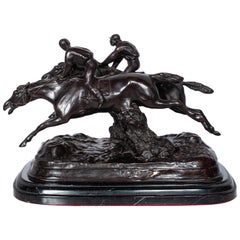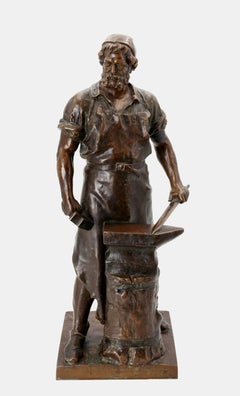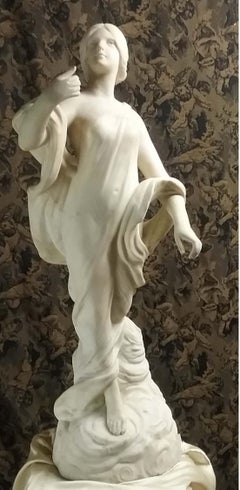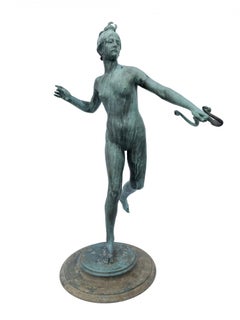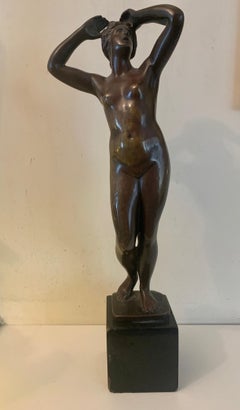1890s Figurative Sculptures
to
9
16
7
9
1
1
Overall Width
to
Overall Height
to
175
582
2,194
7,434
71
43
112
115
59
124
203
173
217
269
60
29
23
19
19
14
9
5
5
3
2
2
1
1
1
1
1
1
1
1
1
30
26
5
4
2
1
1
1
1
1
17
17
Period: 1890s
Antique French 19th Bronze Equestrian Group Horses Jockeys Statue Sculpture 1895
Located in Portland, OR
A fine late 19th century antique French bronze sculpture group, of a pair of race horses & jockeys, by Paul Louis Emile Loiseau-Rousseau, Paris (1861-1927).
The bronze circa 1895 de...
Category
French School 1890s Figurative Sculptures
Materials
Bronze
The Blacksmith of Solingen / - The Double-edged Sword -
Located in Berlin, DE
Wilhelm Albermann (1835 Werden an der Ruhr - 1913 Cologne), The Blacksmith of Solingen, after 1895. Bronze-color patinated zinc cast on plinth, 47 cm (height) x 20 cm (width) x 16 cm (depth), weight 5.5 kg. Signed “Albermann.” on the plinth and identified as a cast by “AKT.[TIEN] GES.[ELLSCHAFT] GLADENBECK BERLIN”. Dedication on the front: “Mr. Ing. F. Kuhlmann to the wedding. Management and officials of the Hannoversche Waggonfabrik. Aircraft construction department".
- The zinc showing through in spots, the patina somewhat stained, the right upper arm under the sleeve retouched in black.
- The Double-edged Sword -
The figure is a reduction of Wilhelm Albermann's 1895 fountain figure of the armourer of Solingen, who has always been identified with the historical blacksmith Peter Hahn. In 1839, Karl Simrock wrote the poem “The Blacksmith of Solingen" and thus coined the legendary figure. The first and penultimate verses read:
A blacksmith spoke to Solingen
With every bayonet,
That came to his diligence:
"Oh, that Fritz had it!"
The war took its course,
Many battles were fought,
Which often made him fearful and anxious
In his soul.
The blacksmith had given up his trade to fight for Frederick the Great. Not least because of his strength and will to fight, the battles were won. With his fountain sculpture, Albermann has given the legendary blacksmith a figurative form and at the same time created a landmark for the city of Solingen, which was once famous for the art of sword forging and today still stands for the production of high-quality knives. During the bombing raid in November 1944, the fountain was destroyed along with the entire old town of Solingen. Only the head remained.
The broad-shouldered blacksmith stands securely behind his anvil, his leather apron tied around him, and has just finished a sword blade with his own "weapon" - the blacksmith's hammer. His entire body shows the strength with which he wields the hammer, but also the strain of this activity, as evidenced by the wide open shirt, the somewhat 'untidy' apron, and especially the furrowed face.
However, the blacksmith does not look at the finished work, but resolutely and at the same time thoughtfully into the distance, in line with the quoted verse from Simrock's poem that the battles "often made him fearful and anxious in his soul". There is certainly something melancholy in his gaze, fed by the knowledge of the necessity of forging swords and taking up arms and their deadly use - experiences Albermann had to make during his own war missions. The flowing full beard gives his gaze into the distance an almost prophetic character.
In keeping with the craft of the perfectly formed art of blacksmithing, the detailed casting reproduces the respective materials depicted in perfect form: the leather apron convincingly conveys the impression of leather and lies - also in the back view - like a second formed layer over the body, while the shirt and trousers illustrate their own textile qualities.
Due to its masterful execution and profound content, the “Blacksmith of Solingen”, which has survived in its cast reproductions, remains Albermann's most famous work to this day.
About the artist
The son of a carpenter, Wilhelm Albermann began an apprenticeship as a joiner, but then followed his artistic calling and trained as a sculptor in Elberfeld. In 1855, at the age of twenty, he was drafted into the army in Berlin, where he served until 1857. Albermann attended the Berlin Art Academy on the side and began regular studies after his service. While still a student, he completed commissioned works for his teachers August Fischer and Hugo Hagen. His first independent commissions followed, enabling him to establish a flourishing sculpture studio in Cologne in 1865. His artistic activities were repeatedly interrupted by military service, and he took part in the German-Danish War in 1864, the war against Austria in 1866, and the Franco-Prussian War in 1870/71. After his last war service, Albermann, already a respected artist, founded a commercial drawing school at the request of the city government, where he taught the modeling class and served as director until 1896. In 1890 he also worked for the "Society for the Promotion of Sculpture in the Rhineland and Westphalia".
Albermann was one of the most prolific sculptors in Cologne in the second half of the 19th century. He created numerous monuments, fountains, tomb sculptures, architectural ornaments, and domestic statues. At its peak, his workshop employed up to thirty sculptors and stonemasons at a time.
GERMAN VERSION
Wilhelm Albermann (1835 Werden an der Ruhr - 1913 Köln), Der Schmied von Solingen, nach 1895. Bronzefarben patinierter Zinkguss auf gegossener Plinthe, 47 cm (Höhe) x 20 cm (Breite) x 16 cm (Tiefe), Gewicht 5,5 kg. Auf der Plinthe mit „Albermann.“ signiert und als Guss der „AKT.[TIEN] GES.[ELLSCHAFT] GLADENBECK BERLIN“ ausgewiesen. Schauseitige Widmung: „Herrn Ing. F. Kuhlmann zur Vermählung. Direktion und Beamte der Hannoverschen Waggonfabrik. Abt. Flugzeugbau“.
- Punktuelles Durchscheinen des Zinks, Patina etwas fleckig, der rechte Oberarm unter dem Ärmel schwarz retuschiert.
- Die Zweischneidigkeit des Schwertes -
Die Figur ist eine Reduktion von Wilhelm Albermanns 1895 geschaffener Brunnenfigur des Waffenschmieds von Solingen, der seit jeher mit dem historischen Schmied Peter Hahn identifiziert wurde. 1839 hatte Karl Simrock das Gedicht „Der Schmied von Solingen“ verfasst und damit die legendäre Figur geprägt. Die erste und die vorletzte Strophe lauten:
Zu Solingen sprach ein Schmied
Bei jedem Bajonette,
Das seinem Fleiß geriet:
»Ach, daß der Fritz es hätte!«
Der Krieg ging seinen Gang,
Man schlug noch viele Schlachten,
Die oft ihm angst und bang'
In seiner Seele machten.
Der Schmied hatte sein Handwerk ruhen lassen, um selbst für Friedrich den Großen zu kämpfen. Nicht zuletzt durch seine Kraft und seinen Kampfeswillen verliefen die Schlachten siegreich. Dem legendären Schmied verlieht Albermann mit seiner Brunnenskulptur eine bildliche Gestalt und schuf damit zugleich ein Wahrzeichen der Stadt Solingen, die einst für die Kunst des Schwerterschmiedens berühmt war und bis heute für die Herstellung qualitätvoller Messer einsteht. Beim Bombenangriff im November 1944 wurde mit der gesamten Solinger Altstadt auch der Brunnen zerstört. Einzig der Kopf blieb erhalten.
Mit sicherem Stand und umgebundener Lederschürze steht der breitschultrige Schmied hinter seinem Amboss und hat gerade mit seiner eigenen ‚Waffe‘ – dem Schmiedehammer – eine Schwertklinge fertiggestellt. Seinem gesamten Körper ist die Kraft abzulesen, mit der er den Hammer führt, aber auch die Anstrengung dieser Tätigkeit, wovon das weit geöffnete Hemd, die etwas ‚unordentlich‘ arrangierte Schürze und vor allem das zerfurchte Gesicht zeugen.
Der Schmied schaut aber nicht auf das vollendete Werk, sondern entschlossen und zugleich sinnierend in die Ferne, entsprechend der zitierten Zeile von Simrocks Gedicht, dass die Schlachten „oft ihm angst und bang‘ in seiner Seele machten“. Der Blick hat durchaus etwas Melancholisches, dass sich aus dem Wissen um die Notwendigkeit, Schwerter zu schmieden und zu den Waffen zu greifen und deren tödlichem Einsatz speist – Erfahrungen, die Albermann bei seinen eigenen Kriegseinsätze machen musste. Der wallende Vollbart verleiht dem in die Ferne schauenden Blick einen beinahe prophetischen Charakter.
Dem Handwerk der formvollendenden Schmiedekunst entsprechend, gibt der detaillierte Guss die jeweils dargestellten Materialien in vollendeter Ausformung wieder: Die Lederschürze vermittelt überzeugend den Eindruck des Leders und liegt – auch in der Rückenansicht – wie eine zweite ausgeformte Schicht über dem Körper, während das Hemd und die Hose...
Category
Realist 1890s Figurative Sculptures
Materials
Metal
$1,341 Sale Price
20% Off
Inspiration
Located in Los Angeles, CA
Beautiful Art Nouveau marble.
Campagne, Pierre Étienne Daniel French , 19th century , male. Active in Paris. Born 1851 , in Gontaud (Lot-et-Garonne). S...
Category
Art Nouveau 1890s Figurative Sculptures
Materials
Marble
Diana the Huntress, 1890 Classical Bronze Sculpture of Nude Woman
Located in Beachwood, OH
Frederick William MacMonnies (American, 1863-1937)
Diana, 1890
Bronze with green verdigris patina
Signed and dated
Copyright 1894 with Jaboeuf & Rouard, Paris foundry mark
31 x 21 x 17 inches
A sculptor of classical figures, American-born Frederick MacMonnies...
Category
1890s Figurative Sculptures
Materials
Bronze
19th century French Bronze of a naked woman standing up.
Located in Woodbury, CT
Well modeled 19th century French bronze of a standing naked woman.
Signed Cartinet, this piece is a wonderful example of the skill of a Sculptor.
The piece retains all its origina...
Category
Victorian 1890s Figurative Sculptures
Materials
Bronze
$1,356 Sale Price
20% Off
"Salut Au Soleil"
By Georges Dupre
Located in Southampton, NY
French, 1899 SALUT AU SOLEIL, art medal, in bronze by Georges Dupré, in fine condition, (Dark oxidation spot to right of larger figure, slight surface vertical scratch verso); edge ...
Category
Academic 1890s Figurative Sculptures
Materials
Bronze
Apple Dancer
Located in PARIS, FR
Apple Dancer
by Jean-Léon GEROME (1824-1904)
Bronze sculpture with a dual patina, brown and gilded
signed on the base "JL. GEROME"
cast by "Siot-Decauville Fondeur Paris" (foundry s...
Category
Art Nouveau 1890s Figurative Sculptures
Materials
Bronze
THE SPRING
Located in Los Angeles, CA
Beautiful La Belle Epoque marble in nive vintage condition.
Mathurin Moreau (1822-1912) was a French sculptor in the academic style. He was born in Dijon, first exhibited in the 1848 Salon, and finally received a medal of honor...
Category
Academic 1890s Figurative Sculptures
Materials
Marble
$5,700 Sale Price
40% Off
Antique French Polish Gilt Bronze Statue Sculpture Figure Sword Bladesmith 1890
Located in Portland, OR
A fine antique French gilt bronze sculpture of a swordsmith, by the French- Polish artist & sculptor Henryk II Kossowski (1855-1921), the bronze dating to 1890.
The bronze depicts a ...
Category
French School 1890s Figurative Sculptures
Materials
Alabaster, Bronze
Pecheur / - Full of anticipation -
Located in Berlin, DE
Adolphe Jean Lavergne (1863-1928), Pecheur, c. 1900. Brown patinated bronze with rectangular cast plinth on a green marble base (3 cm high), total height with hinge 37 cm, width 9 cm, depth 8 cm, weight 2.9 kg, signed “Lavergne” on the plinth.
- Base with old drilling and a few oxidized areas, patina occasionally rubbed, somewhat stained in the folds.
- Full of anticipation -
This bronze is the larger, highly detailed version of the fisherman that made Parisian artist Adolphe Jean Lavergne famous. In preparation for fishing, the boy prepares his rod before heading out to sea. The attachment of the iron ring and the rope behind him suggest a quay wall and a boat moored there. However, the depiction is entirely focused on the actual action of the young fisherman: With equal skill and concentration, he bends a hook to connect it to the fishing line. The contrast with his casual clothing, the loose-fitting trousers, the open shirt with its "wild" folds, and, last but not least, the sun hat boldly perched on his neck, reinforces the impression of the attentive care with which he goes about his work. His gaze makes him appear absorbed, as if he has forgotten the world around him and yet he is visibly filled with anticipation of fishing.
GERMAN VERSION
Adolphe Jean Lavergne (1863-1928), Pecheur, um 1890. Braun patinierte Bronze mit rechteckiger gegossener Plinthe auf grünem Marmorsockel (3 cm Höhe), Gesamthöhe mit Angel 37 cm, Breite 9 cm, Tiefe 8 cm, Gewicht 2,9 kg, auf der Plinthe mit „Lavergne“ signiert.
- Sockel mit alter Bohrung und wenigen oxidierten Stellen, Patina mitunter berieben, in den Falten vereinzelt etwas fleckig.
- Voller Vorfreude -
Die Bronzefigur ist die größere äußerst detaillierte Ausführung des Fischers, mit dem der Pariser Künstler Adolphe Jean Lavergne bekannt geworden ist. In Vorbereitung auf das Fischen präpariert der Junge die Angel...
Category
Realist 1890s Figurative Sculptures
Materials
Bronze
$689 Sale Price
20% Off
The Victorious David / - The melancholy of the radiant hero -
Located in Berlin, DE
Henri Honoré Plé (1853 Paris - 1922 Paris), The Victorious David, around1890. Red-brown and brown patinated bronze with terrain plinth mounted on a round base. 42 cm (total height) x...
Category
Realist 1890s Figurative Sculptures
Materials
Bronze
$1,820 Sale Price
20% Off
The Victorious David / - The melancholy of the radiant hero -
Located in Berlin, DE
Henri Honoré Plé (1853 Paris - 1922 Paris), The Victorious David, around 1890. Red-brown and brown patinated bronze with terrain plinth mounted on a round base. 62 cm (total height) ...
Category
Realist 1890s Figurative Sculptures
Materials
Bronze
$4,024 Sale Price
20% Off
Antique Spanish Art Nouveau Bronze Neo-Classical Sculpture Statue Bacchante 1890
Located in Portland, OR
A very good antique Neo-Classical bronze of a Bacchante or Maenad, by Spanish sculptor Gustave Obiols Delgado (1858-1902). The sculpture circa 1890.
This large & very attractive, fin...
Category
Art Nouveau 1890s Figurative Sculptures
Materials
Marble, Bronze
Französische Bronze Emile Louis Picault „Charity-Bien Faisance“
Located in Berlin, DE
Bronze Emile Louis Picault
"Charity-Bien Faisance," a French bronze figure by Emile Louis Picault.
50 cm
Bronze signed Emile Louis Picault. With cast stamp.
Wonderful work with a ...
Category
Jugendstil 1890s Figurative Sculptures
Materials
Bronze
Pathos
Located in New York, NY
A sensuous and fabulous piece to enjoy in the round as every vantage point is attractive or on a shelf or table.
In the 19th century, the Italians and French were in a golden era f...
Category
Academic 1890s Figurative Sculptures
Materials
Bronze
Young Roman / - Youthful Sprezzatura -
Located in Berlin, DE
Fritz Heinemann (1864 Altena - 1932 Berlin), Young Roman, 1892. Brownish patinated bronze on a cast round plinth, mounted on a red marble base (8.5 cm high), total height 36 cm, dime...
Category
Realist 1890s Figurative Sculptures
Materials
Bronze
$862 Sale Price
20% Off
Agathon Leonard Silvered Bronze Of Marguerite
Located in Dallas, TX
Agathon Leonard (French, 1841 - 1923) Art Nouveau Silvered Bronze
A French Art Nouveau gilt bronze sculpture, "Marguerite", by Agathon Léonard of Margeruite, placing a flower in her...
Category
Art Nouveau 1890s Figurative Sculptures
Materials
Bronze
Eugene Alexandrovich Lanceray (Russian, 1848-1886) Cossack on Horse
Located in Dallas, TX
Evgeny Alexandrovich Lanceray (Russian, 1848-1886)
19th Century, Possibly post humus
Cossack on Horseback
Gilt bronze
signed in Cyrillic
Measures: Height 8 3/4 x width 8 3/4 inches....
Category
1890s Figurative Sculptures
Materials
Bronze
Bust of a young woman / - The Opulence of Beauty -
Located in Berlin, DE
Anton Nelson (i.e. Antoine Joseph van den Kerckhoven) (1849 Brussels - after 1910 ibid.), Bust of a young woman, c. 1890. Patinated bronze on cast base, 30 cm (total height) x 20 cm ...
Category
Art Nouveau 1890s Figurative Sculptures
Materials
Bronze
French Art Nouveau bronze by Franz Rosse 1893
Located in Berlin, DE
A late 19th-century French bronze sculpture titled "Fairy with Butterfly" by Franz Rosse (1858-1900), signed and dated "Frosse 93" on the base, depicting a semi-dressed woman floatin...
Category
Jugendstil 1890s Figurative Sculptures
Materials
Bronze
Teak wood sculpture of a Sage - circa 1890, China
Located in Vicenza, VI
This teak wood carving represents an essay made in the Chinese craft tradition at the end of the 19th century: circa 1890. Overall size 81x27x26 cm. Teak wood is known for its streng...
Category
Other Art Style 1890s Figurative Sculptures
Materials
Wood
Allegory of Progress / - The Driving Force of Inspiration -
Located in Berlin, DE
Ernest Rancoulet (1842-1918), Allegory of Progress, around 1890. Bronze-plated metal cast with cast terrain plinth mounted on a wooden base (6 cm high). 64.5 cm (total height) x 28 c...
Category
Realist 1890s Figurative Sculptures
Materials
Metal
Bronze Spanish naturalistic 19th century sculpture of a young boy
Located in Woodbury, CT
An amazing bronze cast of a little 19th-century boy. The quality of the piece is outstanding, as is the color and patination.
There is little known about the painter other than he wo...
Category
Naturalistic 1890s Figurative Sculptures
Materials
Bronze
$2,200 Sale Price
20% Off
"Reclining Woman" Karl Bitter, Reclining Woman with Reddish Patina
Located in New York, NY
Karl Bitter
Reclining Woman, 1897
Signed: Bitter 97
Stamped: GORHAM M F G CO.
Bronze
10.25 x 10.25 x 4 inches
Initially from Vienna, Karl Bitter first studied art at the city’s Kunstgewerbeschule and the Kunstakademie before being drafted into the Austrian army. He deserted his position in the military while on leave, and departed for New York City where he would discover considerable success. Early on, he won a competition for the Astor memorial bronze gates at Trinity Church, which awarded him enough capital to open his own studio. He went on to execute sculptures of Alexander Hamilton and Thomas Jefferson at the Cuyahoga Courthouse in Cleveland; he also created portraits of Jefferson for the state of Missouri and the University of Virginia. These commissions caught the attention of sculptor Richard Morris Hunt (who famously designed the façade of the Metropolitan Museum), earning Bitter the duty of producing the portrait medallions that now appear near the top of the museum’s grand face.
Notably, he presented at Chicago’s 1893 World’s Columbian Exposition and directed the Pan-American Exposition in Buffalo in 1901. Over his career, his artwork became more flexible – his early academy training is easily identifiable within his work, but after moving to America, conventions of Modernism became more prevalent within his sculpture. In addition to many awards, Bitter presided over the National Sculpture Society in 1906-1907, and was a member of the National Institute of Arts and Sciences, the National Academy of Design, the American Academy of Arts and Letters, the Architectural League, and the Art Commission, New York. His public work can be found at the Biltmore Estate, Asheville, NC; Gettysburg National Military Park, Gettysburg, PA; Wisconsin State Capitol, Madison, WI; United States Naval Academy...
Category
Realist 1890s Figurative Sculptures
Materials
Bronze
Fender Guitar Glass Sculpture
Located in Lake Worth Beach, FL
Fender Guitar Multi Layers Glass Sculpture
Artist signed and dated '98, mixed media, layers of multi color dichroic glass, ceramic tiles, aluminum on wooden base.
William Wertz was born in 1946 dide in (2021 Los Angeles). American artist, teacher and photographer. Known for his unique assemble layers of glass sculpture.
His art can be found in Musee des Decoratifs, Paris, the country of Oman (stained glass dome...
Category
1890s Figurative Sculptures
Materials
Metal
Hunting dog on the prowl / - Following the scent -
Located in Berlin, DE
Jules Moigniez (1835 Senlis - 1894 St-Martin-du-Tertre), Hunting dog on the prowl, around 1880. Dark patinated bronze with naturalistic terrain plinth, 16 cm (height) x 30 cm (length...
Category
Naturalistic 1890s Figurative Sculptures
Materials
Bronze
Pair of metal sculptures depicting mythological birds, France, late 19th century
Located in Vicenza, VI
Pair of engraved metal sculptures depicting two mythological birds, traceable to the French sphere and datable to the late 19th and early 20th centuries.
The two sculptures are almos...
Category
Other Art Style 1890s Figurative Sculptures
Materials
Metal
The Age of Innocence - New Sculpture bronze bust by Alfred Drury
Located in London, GB
ALFRED DRURY, RA
(1856-1944)
The Age of Innocence
Signed: A DRURY
Bronze on green marble base
Height including base 45.5 cm., 18 in.
Born in Islington...
Category
Realist 1890s Figurative Sculptures
Materials
Bronze
Planter "The Pond"
By Raoul Larche
Located in PARIS, FR
Planter "The Pond"
by Raoul LARCHE (1860-1912)
Plant-holder in bronze with a nuanced dark brown patina
Signed " Raoul Larche "
Cast by " Siot-Decauville fondeur Paris " (with the fo...
Category
Art Nouveau 1890s Figurative Sculptures
Materials
Bronze
French Bronze Sculpture Statue by Alexandre Dercheu
Located in New York, NY
JULES-ALFRED-ALEXANDRE DERCHEU
French, (1864-1912)
L'Amour Désarmé
A nude girl holding Cupid away with her left arm, her left foot on his quiver, on a circular base, seated on a ro...
Category
1890s Figurative Sculptures
Materials
Bronze
Important pocket-tray with sea gods
Located in PARIS, FR
Important pocket-tray with sea gods
by Gustave MICHEL (1851-1924)
A very fine bronze group with a gilded patina
signed on the side of the base "G. Michel"
cast by "Siot-Decauville ...
Category
French School 1890s Figurative Sculptures
Materials
Bronze
$8,623 Sale Price
20% Off
Scultura in marmo italiana ritratto di fanciulla religiosa del XIX secolo
Located in Florence, IT
Il busto marmoreo, datato 1890, appartiene alla sua età adulta, nello specifico all’ultimo anno della sua vita, quando era molto richiesto e aveva uno studio molto prolifico a Firenz...
Category
Realist 1890s Figurative Sculptures
Materials
Marble
Bronze Statue of Prince Albert Edward as a Sailor Boy
Located in Costa Mesa, CA
This statue is of Prince Albert Edward, eldest son of Queen Victoria, Prince of Wales, future King Edward VII (1841-1910) dressed in a sailor suit. After a very popular painting of the young prince done in 1846 by Franz Xaver Winterhalter (1805-73) that is in the collection of the British Royal Family.
Category
Victorian 1890s Figurative Sculptures
Materials
Bronze
Jockey On Horseback
By Hans Guradze
Located in Missouri, MO
Hans Guradze (German, 1861-1922)
"Jockey On Horseback"
Bronze
Approx. 19.5 x 17 x 6 inches
Signed "H. Guradze Berlin" on Base
Category
Realist 1890s Figurative Sculptures
Materials
Bronze
Price Upon Request
